Delightful Devi Garh
 The egg-yolk dawn sun peeks over the edge of a crag, slowly lighting the jagged, receding Aravali Hills, and the bowl-shaped, undulating plain of patchwork tilled and grazing fields, mottled grey-green brown in this, the third year of North Indian drought. Rounded and flat-topped Neem, Peepal and Acacia trees cast long shadows against the amber early light, and cows, goats, monkeys and camels amble seemingly aimlessly, while people start the day’s business. Brown skinned, white dhoti-clad farmers squat to tend the plants in their small, meticulous fields, or stoop to hand pump water to nourish the precious crops. Women in incredibly bright saris—fuchsia, crimson, cobalt, lime, orange—some with arms and ankles festooned with literally pounds of silver
The egg-yolk dawn sun peeks over the edge of a crag, slowly lighting the jagged, receding Aravali Hills, and the bowl-shaped, undulating plain of patchwork tilled and grazing fields, mottled grey-green brown in this, the third year of North Indian drought. Rounded and flat-topped Neem, Peepal and Acacia trees cast long shadows against the amber early light, and cows, goats, monkeys and camels amble seemingly aimlessly, while people start the day’s business. Brown skinned, white dhoti-clad farmers squat to tend the plants in their small, meticulous fields, or stoop to hand pump water to nourish the precious crops. Women in incredibly bright saris—fuchsia, crimson, cobalt, lime, orange—some with arms and ankles festooned with literally pounds of silver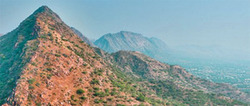 and gold jewelry—balance brass or clay pots, huge bundles of firewood or large woven baskets on their heads and glide serenely along the roadsides into the village of Delwara. A tree shakes with the activity of a troop of monkeys acrobatically jumping and swinging, and finally dropping to bounce and run along a the top of a stone wall.
and gold jewelry—balance brass or clay pots, huge bundles of firewood or large woven baskets on their heads and glide serenely along the roadsides into the village of Delwara. A tree shakes with the activity of a troop of monkeys acrobatically jumping and swinging, and finally dropping to bounce and run along a the top of a stone wall.
The day brightens, and the Aravalis glow russet and red-gold in the morning sunlight, while the dawn-line crawls up the mottled yellow walls and turrets of the stacked levels that make up the compound of the Devi Garh Fort Palace Hotel, the roof of which is my early morning vantage point to view this activity.
Devi Garh is a massive presence looming out of a rocky outcrop in the hill-surrounded bowl-plain, and towers  over the nearby village of Delwara. Built originally in the mid 18th century by the Maharana Rughuchev Sing II, Devi Garh was a fort-palace guarding one of the three strategic passes into the Udaipur Valley in a time of continuous war against the Mughal invaders. It was expanded and extended by successive rulers, and finally abandoned in the 60’s, after independence in 1955 effectively did away with royalty in India, until acquisition and commencement of restoration by interests from Delhi in the mid 90’s. At the time substantially in ruins, it took seven years, massive hand labor, and millions to create that which greets the visitor today—an elegant, luxurious yet still
over the nearby village of Delwara. Built originally in the mid 18th century by the Maharana Rughuchev Sing II, Devi Garh was a fort-palace guarding one of the three strategic passes into the Udaipur Valley in a time of continuous war against the Mughal invaders. It was expanded and extended by successive rulers, and finally abandoned in the 60’s, after independence in 1955 effectively did away with royalty in India, until acquisition and commencement of restoration by interests from Delhi in the mid 90’s. At the time substantially in ruins, it took seven years, massive hand labor, and millions to create that which greets the visitor today—an elegant, luxurious yet still 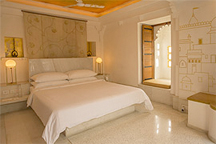 authentic and historic all-suite small luxury hotel. The Palace contains just 23 suites, plus five luxury tents overlooking the lower kitchen garden, but provides tremendous space for those few guests. There are many courtyards, some with interesting and unique fountains, some with geometric combinations of stone and plantings, over a dozen of terraces, stone balconies, and domed corner cupolas, spread over five different levels, offering a 360 degree view of the Rajasthan countryside. An antique-furnished library, open to its own courtyard, provides an additional place for reading and reflection, and another level up lays a billiard room for those inclined to billiards or snooker.
authentic and historic all-suite small luxury hotel. The Palace contains just 23 suites, plus five luxury tents overlooking the lower kitchen garden, but provides tremendous space for those few guests. There are many courtyards, some with interesting and unique fountains, some with geometric combinations of stone and plantings, over a dozen of terraces, stone balconies, and domed corner cupolas, spread over five different levels, offering a 360 degree view of the Rajasthan countryside. An antique-furnished library, open to its own courtyard, provides an additional place for reading and reflection, and another level up lays a billiard room for those inclined to billiards or snooker. 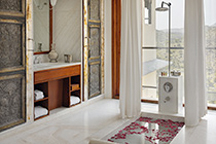
On the entrance side, lovely and manicured terraced gardens with fragrant and colorful trees and bushes provide space for leisurely strolls past bubbling fountains and a rushing canal bordering the entrance steps, or a ruthless game on the croquet pitch. On the south side, sits the spa and the cobalt-blue pool and pool terrace, overlooking the gardens and garden suites—a serene place for sunning, relaxing and reading. Our suite, #22, one of the Palace Suites, is at the highest point in the palace, under a cupola-capped dome, and contains two sitting areas, bedroom and spectacular bathroom with marble sunken tub. It offers dramatic views of the ancient Aravali Hills from two sides, and the pool terrace and gardens on a third. Slickly furnished in a combination of 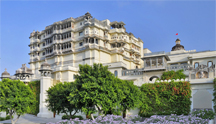 Indian antiques and custom furniture, with inlaid marble floors, the ambience is polished and sharp, with an aerie-like feeling.
Indian antiques and custom furniture, with inlaid marble floors, the ambience is polished and sharp, with an aerie-like feeling.
Devi Garh’s kitchen produces very good Indian and European fare. At various meals we sample crispy-fried, gram-flour dusted okra—Bhindi Kurkiri; moist and spicy Tandoori chicken; Aloo Chaat—crisp-brown potato chunks topped with cilantro and tamarind chutneys & yoghurt; crusty battered pakoras of single leaves of spinach; rich and creamy Dal Makhani; and plain and stuffed flatbreads—naan, kulcha and paratha—hot and black-flecked from the fiery clay tandoor pot-ovens. Hyderabadi Gosht Biryani is a fragrant, subtle mix of lamb, crisp fired onions & basamati rice. Smoked tomato paneer Makhani combines cubes of fresh mozarrella-like cheese with an unctuous sauce of slightly smoky tomato, butter and cream scented with fenugreek. Baingan Ka Bharta is the classic combination of smoky, fire roasted eggplant with ginger garlic, cumin and chilis.
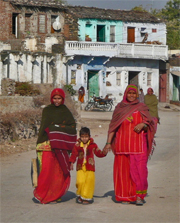 The village of Delwara spreads out below the fort palace, narrow lanes winding through stone and plaster homes, huts and tiny shops. Not wide enough for vehicles, the streets teem with children, bicycles, pigs, goats and, of course, sacred cows. Open-front shops line the two-block “main street”, chilis, spices, lentils, beans and vegetables arrayed at street level, with packaged and canned goods of all sorts stacked inside. People are friendly, some nod, some stare at the white foreigner, but not in a malicious way. Children invariably babble “hello, “bye-bye” and “what your name”, and, only occasionally “one rupee” or “one Bic” the India-wide schoolchildren’s plea for a pen. [after our last trip, we had vowed to bring dozens to distribute, but didn’t remember, and wished we had]. The children are, interestingly, more often than not strikingly handsome little boys and beautiful little girls. They are poor and barefoot, but clean and neat as can be expected, given the drought and poverty level.
The village of Delwara spreads out below the fort palace, narrow lanes winding through stone and plaster homes, huts and tiny shops. Not wide enough for vehicles, the streets teem with children, bicycles, pigs, goats and, of course, sacred cows. Open-front shops line the two-block “main street”, chilis, spices, lentils, beans and vegetables arrayed at street level, with packaged and canned goods of all sorts stacked inside. People are friendly, some nod, some stare at the white foreigner, but not in a malicious way. Children invariably babble “hello, “bye-bye” and “what your name”, and, only occasionally “one rupee” or “one Bic” the India-wide schoolchildren’s plea for a pen. [after our last trip, we had vowed to bring dozens to distribute, but didn’t remember, and wished we had]. The children are, interestingly, more often than not strikingly handsome little boys and beautiful little girls. They are poor and barefoot, but clean and neat as can be expected, given the drought and poverty level.
On the outskirts is a Jain temple dating to the 9th century, and our Devi Garh escort/guide fetches the widow 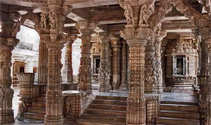 who tends it, who has the key. Jain temple bell-domes, called samavarna, are a sort of elongated egg shape, and this complex has five. The widow places a bindi—small golden dot of scented sandalwood paste on our foreheads, lights incense, and we are free to wander the dusk-lit temple. It is simply festooned with wonderful, intact and undamaged carvings—Jain and Hindu dieties, scenes of the royal court, processions, marriages, and in several dozen side-cells, the Jain gods Tirthankar, looking like seated Buddhas, but with baleful glaring painted eyes that turn the normally serene look of a Buddha into something intense and almost challenging. We are shown a trap door that opens to a tunnel which burrows 10 km into the surrounding hills, and was used for escape by the villagers during muslim attacks some 250 years ago.
who tends it, who has the key. Jain temple bell-domes, called samavarna, are a sort of elongated egg shape, and this complex has five. The widow places a bindi—small golden dot of scented sandalwood paste on our foreheads, lights incense, and we are free to wander the dusk-lit temple. It is simply festooned with wonderful, intact and undamaged carvings—Jain and Hindu dieties, scenes of the royal court, processions, marriages, and in several dozen side-cells, the Jain gods Tirthankar, looking like seated Buddhas, but with baleful glaring painted eyes that turn the normally serene look of a Buddha into something intense and almost challenging. We are shown a trap door that opens to a tunnel which burrows 10 km into the surrounding hills, and was used for escape by the villagers during muslim attacks some 250 years ago.
Devi Garh is 25 km and 45 minutes (given Indian traffic—pedestrians, bicycles, scooters, ox carts, cows, camels, packed buses, top-heavy trucks all on a windy, barely two lane road) from Udaipur and all of its rich sights—the City Palace & Pratap Museum, Pichola Lake and the Lake Palace, the island palace of Jag Mandir (built by the creator of the Taj Mahal) the Jagadishji Temple, and the Gulab Bagh rose garden, all of which combine for a full day sightseeing excursion from the calm and serenity of Devi Garh. About 15 minutes out the Udaipur road, a turning leads to the ancient Jain temples of Sas-Bahu at Nagda, the ancient capital of Mewar. Built in the 10th century, the temple complex, no longer in religious service, contains several beautiful and intricately carved temples depicting Brahma, Shiva and Vishnu, gods of the Hindu pantheon, stories from the Ramayana epic, and, like the temples at Kajuraho, explicit erotic carvings, some graphically depicting multiple participants in quite fantastic interlocked poses.
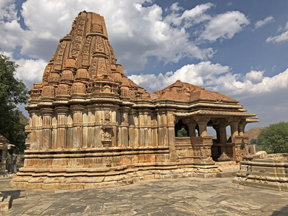 Halfway back to the palace from an Udapipur visit, the still working Hindu temple of Eklinji, the personal temple of the present Maharana of Udaipur (he comes every Monday evening to worship) offers an interesting view into Hindu religious practices. Leaving shoes and any leather items outside, we enter, buy flower garlands and small nuts and sweets from squatting vendors to offer to the Shiva idol in the center of the main temple, and wander the temple complex for a half hour until the commencement of the evening ceremony. Here, three times daily, priests and acolytes wash and decorate the four-faced black marble head of Shiva, god of destruction. First doused with water, Shiva is then successively plied with milk, curd, honey, ghee and grain, sluiced down between each “course”. The chief priest (a cousin of our guide) chants mantras the whole while, and the head is finally decorated with sandalwood and saffron paste—“made up” so to speak, festooned with garlands, flowers, gold coils representing snakes, and surrounded by marigolds. Three seated musicians play tabla drum, a type of floor accordion, and cymbals intermittently during the service, and sing and chant in accompaniment. Worshipers circle in line around the centrally seated musicians, making their donations and obeisance at a special counter manned by an acolyte all during the 45 minute services. At a signal, all ladies in the temple sit on the floor, and the priest then ceremoniously waves a smoking censer, followed by a lit oil lamp, in intricate patterns around the idol, while his acolytes energetically ring three different-toned bells to complete the intricate ceremony in the gathering dusk.
Halfway back to the palace from an Udapipur visit, the still working Hindu temple of Eklinji, the personal temple of the present Maharana of Udaipur (he comes every Monday evening to worship) offers an interesting view into Hindu religious practices. Leaving shoes and any leather items outside, we enter, buy flower garlands and small nuts and sweets from squatting vendors to offer to the Shiva idol in the center of the main temple, and wander the temple complex for a half hour until the commencement of the evening ceremony. Here, three times daily, priests and acolytes wash and decorate the four-faced black marble head of Shiva, god of destruction. First doused with water, Shiva is then successively plied with milk, curd, honey, ghee and grain, sluiced down between each “course”. The chief priest (a cousin of our guide) chants mantras the whole while, and the head is finally decorated with sandalwood and saffron paste—“made up” so to speak, festooned with garlands, flowers, gold coils representing snakes, and surrounded by marigolds. Three seated musicians play tabla drum, a type of floor accordion, and cymbals intermittently during the service, and sing and chant in accompaniment. Worshipers circle in line around the centrally seated musicians, making their donations and obeisance at a special counter manned by an acolyte all during the 45 minute services. At a signal, all ladies in the temple sit on the floor, and the priest then ceremoniously waves a smoking censer, followed by a lit oil lamp, in intricate patterns around the idol, while his acolytes energetically ring three different-toned bells to complete the intricate ceremony in the gathering dusk.
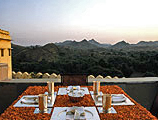 Devi Garh does something very special in the evenings—since most of the year is conducive to outdoor dining, the many courtyards and terraces are used in an ever-changing fashion. You will have dinner in a different venue every evening—the Durbar Hall terrace, the lotus courtyard, the upper balcony, a corner cupola—sometimes multiple guests and tables, sometimes completely private. Tables are strewn with rose-petals, and candles light the corners, niches and alcoves. On our final evening we are privately seated in a candle-lit hall opening onto an upper terrace overlooking the gardens and village—the “prow” of the stone-filigreed terrace the place at which the Maharana once would have greeted and addressed his subjects. Our last supper consists of an interesting mélange we’ve not encountered previously, called Alloo Guchi Hara Pyaz, which pairs potatoes, spring onions and morel mushrooms with garam masala spices and tomatoes, another smoky egglant preparation, cumin-spiced, minced lamb Seekh Kebabs, and masala and yoghurt marinated rack of lamb cooked perfectly in the Tandoor.
Devi Garh does something very special in the evenings—since most of the year is conducive to outdoor dining, the many courtyards and terraces are used in an ever-changing fashion. You will have dinner in a different venue every evening—the Durbar Hall terrace, the lotus courtyard, the upper balcony, a corner cupola—sometimes multiple guests and tables, sometimes completely private. Tables are strewn with rose-petals, and candles light the corners, niches and alcoves. On our final evening we are privately seated in a candle-lit hall opening onto an upper terrace overlooking the gardens and village—the “prow” of the stone-filigreed terrace the place at which the Maharana once would have greeted and addressed his subjects. Our last supper consists of an interesting mélange we’ve not encountered previously, called Alloo Guchi Hara Pyaz, which pairs potatoes, spring onions and morel mushrooms with garam masala spices and tomatoes, another smoky egglant preparation, cumin-spiced, minced lamb Seekh Kebabs, and masala and yoghurt marinated rack of lamb cooked perfectly in the Tandoor.
Returning to our suite, we find that the room boys have set out dozens of ivory votive candles, which, reflecting off the marble, white plaster and silver-gilt room surfaces create a magic glow and mystical atmosphere to close our delightful stay at Devi Garh.